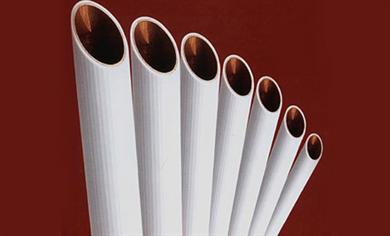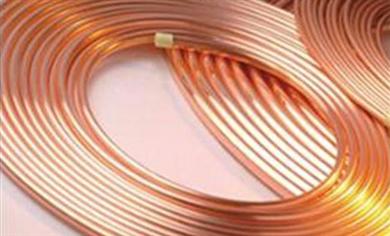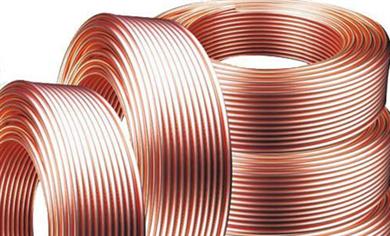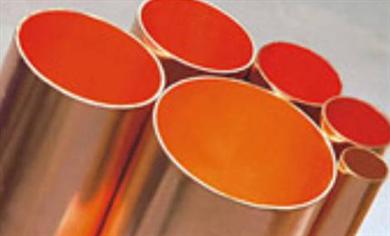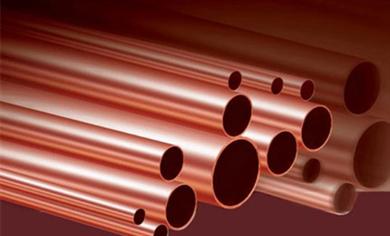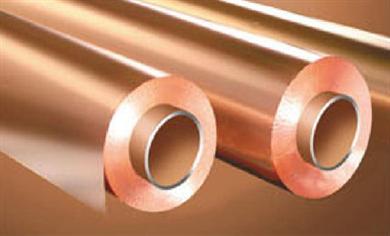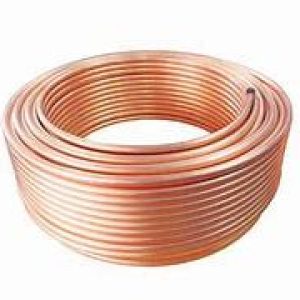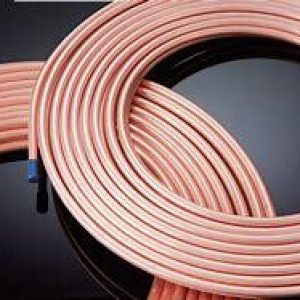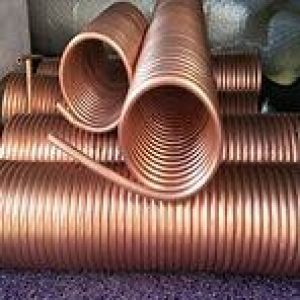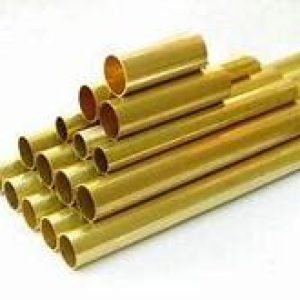Copper Tube Overview
Copper tube: Copper tube, a non-ferrous metal tube. Are pressed and drawn seamless tubes.
Copper water pipe: It is a type of copper pipe, made of high-quality copper. Copper water pipes and pipe fittings are the best choice for water supply, gas supply, and heating pipeline systems. They can be widely used in building cold and hot water supply and drainage, direct drinking water, Reclaimed water, gas, medical, food, chemical and other fields.
Copper coil: widely used as heat exchange equipment in boiler rooms, heat exchange station rooms, and air conditioning machine rooms in heating, air conditioning, and hot water supply systems in industrial and civil buildings.
Plastic-coated copper pipe: Copper-plastic pipe is a water supply pipe made of copper water pipes and PP-R glued together by hot-melt extrusion. The inner layer of the copper-plastic pipe is a seamless pure copper pipe. The water is completely in contact with the copper pipe, and its performance is equivalent to that of a copper water pipe.
Electric furnace tube: The copper tube is wound into a circular shape and has an inductance to generate eddy currents for heating, while the water in the copper tube plays a cooling role.
Copper Tube Performance
Copper pipes are strong and corrosion-resistant, making them the first choice for modern contractors to install water, heating, and cooling pipes in all residential and commercial buildings.
- Copper is economical. Because copper pipes are easy to process and connect, they can save materials and total costs during installation, are stable and reliable, and can save maintenance.
- Copper is lightweight. For internally threaded pipes of the same inner diameter, a copper pipe does not require the thickness of ferrous metal. When installed, copper pipe is less expensive to transport, easier to maintain, and takes up less space.
- Copper can change shape. Because copper pipe can be bent and deformed, it can often be made into elbows and joints. Smooth bends allow the copper pipe to be bent at any angle.
- Copper is easy to connect.
- Copper is safe. Does not leak, does not support combustion, does not produce toxic gases, and is corrosion-resistant.
Copper pipes are hard, not easy to corrode, are resistant to high temperatures and high pressures, and can be used in a variety of environments. In comparison, the shortcomings of many other pipes are obvious. For example, galvanized steel pipes, which were commonly used in residential buildings in the past, are easily corroded. After a short period of use, the tap water will turn yellow, and the water flow will become smaller. The strength of some materials will rapidly decrease at high temperatures, which may cause unsafe risks when used in hot water pipes. The melting point of copper is as high as 1083 degrees Celsius, and the temperature of the hot water system is insignificant to copper pipes. Archaeologists have discovered copper water pipes dating back 4,500 years ago in the Egyptian pyramids, which are still in use today.
Copper Tube Features
Copper water pipes
The inner wall is smooth and will not rust or scale after long-term use. It can avoid secondary water pollution, reduce water head loss, reduce heat energy loss, and inhibit the growth of bacteria in the pipe. It has stronger advantages than other traditional water pipes.
Copper coil
- The heat transfer capacity is improved, and the automatic descaling ability is greatly improved;
- Reduces welding points and makes maintenance more convenient.
- Compact structure, small size, and small floor space.
Plastic-coated copper tube
Purple (pure) copper water pipes have bactericidal and bacteriostatic effects; they also add insulation and protection to copper pipes.
Copper Tube Specification
| Alloy grade | Status | Section size | Length | Guideline | ||
| Outer diameter | Wall Thickness | Inner Diameter | ||||
| T2 TP2 TU2 TU1 C10200 | R | φ60~300 | 5~30 | 500~6000 | GB/T1528-1997 | |
| φ95~120 | 32.5~35 | 500~4000 | Corporate standards | |||
| φ125~200 | 32.5~35 | 300~2000 | ||||
| φ210~250 | 32.5~40 | 300~1500 | ||||
| φ260~300 | 35~65 | 300~800 | ||||
| R | φ300 | φ50~160 | 300~700 | Corporate standards | ||
| φ370 | φ5 0~200 | |||||
| φ420 | φ50~250 | |||||
| M Y | φ15~360 | 0.7~10 | By standard | GB/T1527-1997 | ||
| φ38~300 | 10.5~17.5 | 500~7000 | Corporate standards | |||
| Y2 | φ15~100 | 0.5~10 | By standard | GB/T1527-1997 | ||
| T2 Tp2 | M | φ6~35 | 0.6~6 | 5800 | GB/T18033-2000 | |
| Y2 | φ6~54 | 0.6~6 | ||||
| Y | φ6~219 | 0.6~6 | 3000 | |||
| M Y2 Y | φ4.76~25 | 0.3~1.5 | 3000~7000 | GB17791-99 | ||
| M | φ4~22.23 | 0.3~1.5 | 80~12kg (Axis roll) | |||
| M | φ7~9.52 | 0.32~0.36 | 70~120kg (Internally threaded shaft reel) | Corporate standards | ||
| M Y | φ6.35~19.05 | 0.5~0.7 | 15000 (Mosquito coil disc) | GB17791-99 | ||
| T2conductive | M | φ8~17.3 | 0.5~0.7 | 1000000~8000000 (Axial reel or cable drum) | Corporate standards | |
| T2 Rectangular, square tube | M Y | Long side A×Short side B×Wall thickness: 5~80×5~80×1.0~10 | Straight strip:1000~5000 L≥6000available discs | Corporate standards | ||
| *Non-standard range products can be negotiated | ||||||
Copper Tube Application
In the aerospace field, copper tubes are mainly used as heaters on aircraft engines and other mechanical equipment. Their high thermal conductivity enables them to better protect the normal operation of machinery and equipment in high-temperature and high-pressure environments.
In the chemical industry, copper tubes are mainly used to manufacture chemical equipment, petrochemical equipment, and related accessories. Copper pipes’ superior corrosion resistance can effectively prevent the corrosion of chemical products on the pipes.
In the construction field, copper tubes are widely used to make pipes and fittings for heating, ventilation, cooling and air conditioning systems. It has excellent thermal conductivity and can quickly transfer heat, allowing heating systems, air conditioning systems, etc. to operate efficiently. At the same time, copper tubes also have excellent corrosion resistance. They are not easily affected by the environment and water quality during long-term use, helping to improve the stability and reliability of building systems.
In the electronics field, copper tubes are used to make cables that connect sensors, as well as to make solar panels, LED lights, and other electronic lighting equipment. In addition, copper tubes are widely used in the manufacturing of semiconductor appliances and high-precision instruments because of their good electrical conductivity and reliable corrosion resistance.
Company Profile
Copper Channel is a trusted global chemical material supplier & manufacturer with over 12-year-experience in providing super high-quality copper and relatives products.
The company has a professional technical department and Quality Supervision Department, a well-equipped laboratory, and equipped with advanced testing equipment and after-sales customer service center.
If you are looking for high-quality copper products, please feel free to contact us or click on the needed products to send an inquiry.
Payment Methods of Copper Tube
L/C, T/T, Western Union, Paypal, Credit Card etc.
Shipment of Copper Tube
It could be shipped by sea, by air, or by reveal ASAP as soon as repayment receipt.
FAQ
What are the advantages of copper tubes compared to other metal tubes?
Answer: Copper tubes have excellent thermal conductivity and corrosion resistance, and are easy to process and install. In addition, copper tubes also have a long service life and good environmental performance.
What should we pay attention to during the installation process of copper pipes?
Answer: When installing copper pipes, you need to pay attention to the bending radius, support and fixation methods of the pipes, as well as the sealing and tightening of the joints. Avoid excessive bending or flattening of pipes to ensure quality installation.
How to maintain copper tubes during use?
Answer: Copper tubes should be inspected regularly during use to detect and deal with possible corrosion, leakage or blockage problems in a timely manner. For exposed parts, protective measures such as applying anti-rust coatings can be taken.
What is the price of copper tubes?
Answer: The price of copper tubes is affected by many factors such as market supply and demand, copper price and processing cost, so the price will fluctuate. Generally speaking, the price of copper tubes is relatively high, but its excellent performance and long life make it highly cost-effective.
Are copper tubes prone to oxidation and corrosion?
Answer: Copper pipes are indeed susceptible to oxidative corrosion in humid environments, but they can be protected by applying anti-rust coatings or using gas-phase rust inhibitors. In addition, choosing good quality copper pipes and proper installation techniques can also reduce the risk of oxidation corrosion.
What should you pay attention to when welding copper tubes?
Answer: When welding copper pipes, you need to choose the appropriate welding process and materials, control the welding temperature and speed, and ensure the quality and sealing of the weld. At the same time, welding personnel need to have certain professional skills and experience to ensure welding quality.
How to deal with the bending and deformation of copper tube?
Answer: The copper tube may be bent and deformed during processing or installation. For slight deformation, it can be processed through heating correction or mechanical correction; for severe deformation, it may be necessary to replace the copper tube with a new one.
